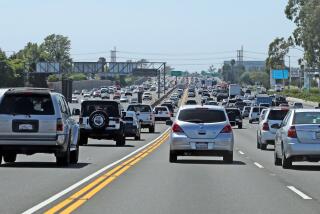Automakers agree to make automatic braking a standard feature by 2022
- Share via
Nearly every American car would be equipped with automatic emergency braking within six years under an “unprecedented” pact announced Thursday between federal regulators and the auto industry.
The agreement was reached between the U.S. National Highway Traffic Safety Administration, the Insurance Institute for Highway Safety and 20 automakers that represent nearly the entire U.S. auto market.
The so-called AEB systems are part of the technological march toward an age of autonomous vehicles. They use on-car sensors such as cameras, lasers and radar to detect an imminent crash and apply the brakes if the driver doesn’t act quickly enough.
They would be standard on all cars and light trucks by 2022. A record 17.5 million cars and light trucks were sold in the United States last year.
“The unprecedented commitment means that this important safety technology will be available to more consumers more quickly than would be possible through the regulatory process,” the NHTSA said.
The automakers include Ford, General Motors, Honda, Toyota, Nissan, Volkswagen, Kia and Tesla Motors.
Having vehicles with automatic braking can reduce rear-end crashes by about 40%, the Insurance Institute for Highway Safety estimates.
But the pact came under renewed attack from some consumer-safety groups, which want to see strict regulations instead.
And some analysts said the agreement might simply prove to formalize the automakers’ existing advancements in driver-assisted safety features.
AEB systems already are available as an option on many vehicles, including mid-priced cars, and often are bundled with other safety features. Those systems can range from several hundred dollars to more than $2,000, depending on the vehicle and the included features.
“It’s become a more ubiquitous feature across most price ranges in just the last couple of years,” said Karl Brauer, an analyst with Kelley Blue Book.
“It’s nice that they’re making this official commitment, but you wouldn’t be competitive” as an automaker “if you didn’t have automatic emergency
braking by 2022 anyway,” he said.
Regardless, bypassing the regulatory process would save three years in making the automatic braking systems standard equipment, according to the NHTSA, which is part of the U.S. Transportation Department.
During that three-year span, having AEB systems built into cars would prevent 28,000 crashes and 12,000 injuries nationwide, according to IIHS estimates.
“By proactively making emergency braking systems standard equipment on their vehicles, these 20 automakers will help prevent thousands of crashes and save lives,” U.S. Transportation Secretary Anthony Foxx said in a statement.
But the consumer-safety groups want mandatory regulations on the grounds that the government-industry pact for AEB systems would not require public hearings or be enforceable.
Consumer Watchdog, Ralph Nader’s Center for Auto Safety and former NHTSA administrator Joan Claybrook filed a joint petition with the NHTSA in January seeking such regulations.
“History shows that when car companies don’t comply with federal safety regulations, Americans die,” Consumer Watchdog founder Harvey Rosenfield said in a statement Thursday.
“After the faulty GM ignition-switch and Toyota brake problems that took so many lives, after the Hyundai and VW fuel-economy scandals, you’d think NHTSA would have learned that allowing the automobile industry to regulate itself through secret agreements is a threat to the public health and safety,” Rosenfield said.
The NHTSA said the automakers’ progress in meeting their commitment to install the AEB systems would be monitored by Consumer Reports magazine.
Jake Fisher, director of auto testing for Consumer Reports, said in a statement that the magazine would “hold automakers accountable for their commitments” to making the braking systems as standard equipment.
Initially an option for luxury cars, AEB systems are now also available on such mid-priced models as the Honda Accord and Hyundai Elantra.
The braking systems are one of many safety features now available on cars, including rearview cameras for backing up, alarms that warn drivers when they’re drifting out of their lanes and sensors that detect cars in a driver’s blind spot.
But equipping nearly all cars with braking systems that automatically engage “is absolutely a step toward autonomous vehicles,” said Ed Kim, a vice president at the research firm AutoPacific Inc. in Tustin.
“In the very near future we’re going to see additions” to the AEB feature such as “taking evasive action,” where the vehicle “not only will brake if necessary but also steer itself around an obstacle,” Kim said.
Brauer cautioned that there’s still a long way to go before autonomous driving becomes reality. Besides having in-car safety technology, vehicles will need to be able to “talk” to one another and with roadway infrastructures in order to move about efficiently and safely, he said.
For example, a self-driving car “would still be limited by the fact that it won’t know that a stoplight is out at an upcoming intersection,” he said.
Nonetheless, another benefit of widespread AEB systems is that “it’s getting consumers aware of how there is new and different technology out there that can help them, whether it’s for convenience or safety-related,” said Jeremy Carlson, a senior analyst with the research firm IHS Automotive.
“It’s starting to get them warmed up for more and more autonomous driving in the future,” Carlson said.
Twitter: @PeltzLATimes







